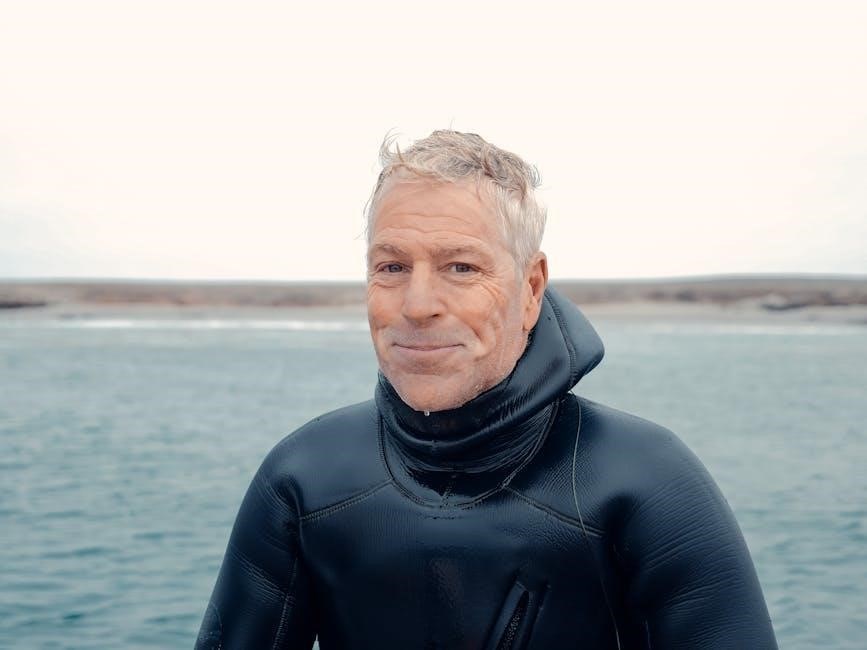scuba diving wetsuit thickness guide
This guide provides essential insights into selecting the right wetsuit thickness for scuba diving, ensuring optimal warmth, mobility, and comfort in various water conditions and diving activities.
Wetsuit thickness refers to the neoprene layer’s measurement, crucial for thermal insulation and comfort during dives, ensuring proper warmth without compromising mobility in varying underwater conditions.
Why Wetsuit Thickness Matters in Scuba Diving
Wetsuit thickness is vital for maintaining body heat, as it slows heat loss in cold water. Thicker suits provide better insulation but may reduce flexibility, while thinner suits offer more mobility. Proper thickness ensures comfort, preventing hypothermia and enhancing diving performance. It also impacts buoyancy, as thicker neoprene affects weight distribution. The right thickness balances warmth and mobility, ensuring a safe and enjoyable dive. Selecting the correct thickness is crucial for adapting to water temperatures and diving conditions, making it a key factor in overall diving success and comfort underwater.
Purpose of the Guide
This guide aims to help scuba divers understand the importance of wetsuit thickness and how to choose the right suit for their diving conditions. It covers key factors like water temperature, activity level, and personal comfort, providing practical advice for selecting the ideal thickness. Whether you’re diving in tropical waters or colder climates, this guide offers insights to enhance your diving experience. Designed for both beginners and experienced divers, it ensures you stay warm, comfortable, and perform at your best underwater. By matching wetsuit thickness to your needs, you can optimize your diving adventures and safety;
Factors Influencing Wetsuit Thickness Choice
Water temperature, diving conditions, activity level, and personal comfort are key factors in choosing wetsuit thickness, ensuring optimal warmth and flexibility for the best diving experience.
Water Temperature and Its Impact
Water temperature significantly influences wetsuit thickness selection. Warmer waters (above 21°C) require thinner suits (1-3mm) for minimal insulation, while colder conditions (below 16°C) demand thicker suits (4-6mm) for warmth. A general rule of thumb is to match the wetsuit thickness to the water temperature to maintain comfort and prevent hypothermia. For example, tropical dives may use 1-2mm suits, while cold-water dives often require 5mm or more. Personal tolerance to cold and diving duration also play a role in thickness choice, ensuring the right balance between warmth and mobility underwater.
Diving Conditions and Activity Level
Diving conditions and activity level significantly impact wetsuit thickness selection. In calm, warm waters with minimal currents, a thinner suit (1-3mm) provides adequate protection while maintaining flexibility. For high-energy activities like swimming or exploring, a slightly thicker suit (3-4mm) offers durability without restricting movement. In colder or rougher conditions, thicker wetsuits (4-6mm) are essential for insulation and protection against abrasions. Additionally, prolonged dives in cold water may require even thicker suits (6mm+) to prevent heat loss. Balancing activity level with environmental factors ensures optimal comfort and performance during dives.
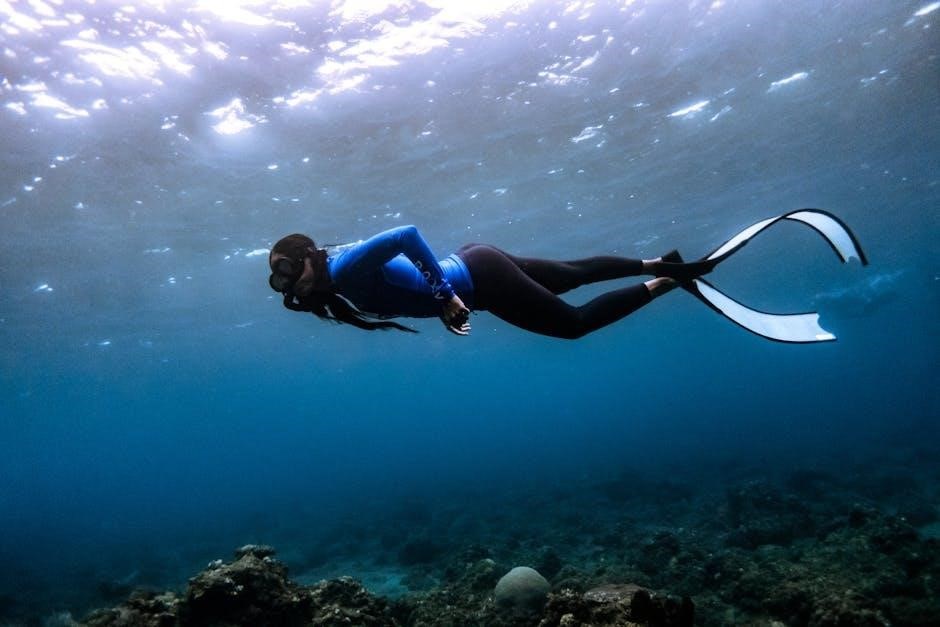
Personal Comfort and Preference
Personal comfort and preference play a crucial role in selecting wetsuit thickness. Some divers prioritize flexibility, opting for thinner suits (1-3mm) for ease of movement, while others prefer thicker suits (4-6mm) for added warmth and protection. Individual tolerance to cold, body type, and sensitivity to neoprene also influence choices. For example, divers with lower body fat or those who feel cold easily may prefer thicker wetsuits. Ultimately, the right thickness is one that balances warmth, mobility, and personal comfort, ensuring an enjoyable and stress-free diving experience. Testing different thicknesses can help determine the ideal fit for individual needs.
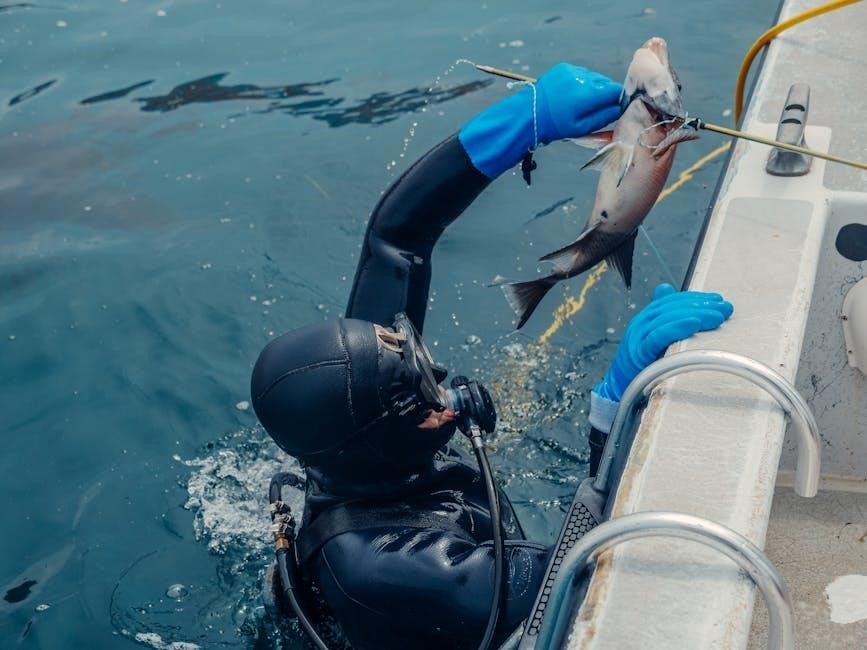
Common Wetsuit Thickness Options
Wetsuits for scuba diving are available in various thicknesses, including 1-2mm, 3mm, 3/2mm, 4-5mm, and 6mm or more, catering to different water temperatures and diving conditions.
1-2mm Wetsuits for Warm Waters
1-2mm wetsuits are ideal for diving in warm waters, typically above 25°C (77°F). These lightweight suits provide basic thermal protection while offering maximum flexibility and comfort. Perfect for tropical destinations like the Maldives or Hawaii, they prevent sun exposure and minor abrasions without restricting movement. Divers prefer this thickness for warm conditions as it maintains body heat without overheating. Suitable for recreational diving, snorkeling, or swimming, 1-2mm wetsuits are a great choice for maintaining comfort in balmy environments while ensuring minimal insulation.
3mm Wetsuits for Moderate Waters
3mm wetsuits are ideal for diving in moderate water temperatures, typically between 16°C and 20°C (61°F to 68°F). This thickness provides excellent thermal insulation while maintaining flexibility, making it suitable for a wide range of diving conditions. Commonly used in regions like the Mediterranean or the Atlantic, 3mm wetsuits strike a balance between warmth and mobility. They are perfect for general recreational diving, offering protection from the cold without feeling bulky. This thickness is also recommended for divers who need consistent warmth but prefer less restriction in their movements, ensuring comfort and performance during underwater activities.
3/2mm Wetsuits for Versatility
3/2mm wetsuits offer exceptional versatility, combining a 3mm torso for core warmth and 2mm limbs for enhanced flexibility. This design is ideal for divers who encounter varying water temperatures or need a balance between warmth and mobility. Suitable for temperatures around 18°C to 22°C (64°F to 72°F), these wetsuits are perfect for transitional seasons or divers who explore multiple regions. The thinner limbs reduce restriction, making it easier to move during dives, while the thicker torso provides adequate insulation. This combination makes 3/2mm wetsuits a popular choice for divers seeking adaptability without compromising comfort or performance in diverse conditions.
4-5mm Wetsuits for Cold Waters
4-5mm wetsuits are designed for diving in cold water conditions, typically between 12°C and 18°C (54°F to 64°F). The increased thickness provides superior insulation, keeping divers warm in chilly environments. These wetsuits are ideal for deeper dives or prolonged exposure in cold waters, offering enhanced thermal protection without sacrificing mobility. The 4-5mm range is a favorite among cold-water divers, striking a balance between warmth and flexibility. Popular for regions like Northern Europe, the Great Lakes, or high-latitude diving spots, these suits ensure comfort and performance in colder climates, making them a must-have for serious cold-water diving enthusiasts.
6mm and Above for Extreme Cold
Wetsuits with a thickness of 6mm or more are tailored for extreme cold-water diving, ideal for temperatures below 10°C (50°F). These suits offer maximum insulation, protecting divers from hypothermia and cold stress in harsh environments. The increased neoprene thickness traps more warm water, providing superior thermal protection. Often used in Arctic or Antarctic diving, these wetsuits are also popular for deep, cold-water technical dives. While they may reduce flexibility slightly, the added warmth ensures safety and comfort in extreme conditions, making them indispensable for serious divers exploring the coldest underwater regions. They are a critical choice for prolonged exposure in frigid waters.
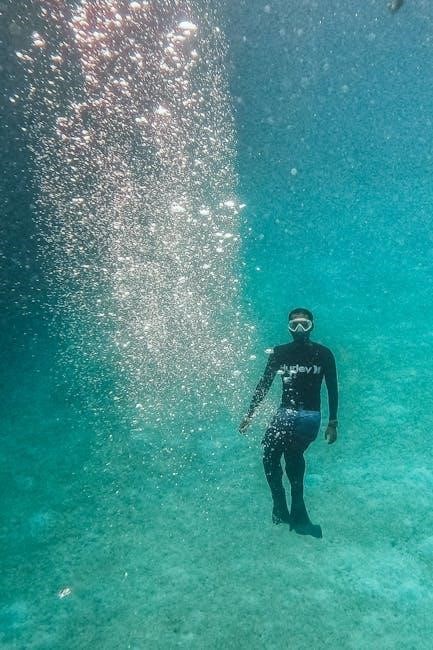
How to Choose the Right Thickness
When selecting a wetsuit thickness, consider water temperature, diving conditions, and personal comfort. Match the neoprene thickness to the water temperature for optimal warmth and flexibility underwater.
Matching Thickness to Water Temperature
Water temperature plays a crucial role in determining the ideal wetsuit thickness. For warmer waters (25-29°C), a 1-3mm wetsuit suffices, while moderate conditions (16-20°C) require 3-5mm. Colder waters (below 16°C) demand 5mm or more for adequate warmth. Consider a 3/2mm split-thickness suit for versatility in varying temperatures. Personal comfort and diving duration also influence thickness selection. Always match neoprene thickness to water temperature for optimal thermal protection and mobility. This ensures a comfortable and safe diving experience across diverse conditions.
Considering Diving Type and Duration
Diving type and duration significantly impact wetsuit thickness selection. Recreational dives in warm waters may require thinner suits (1-3mm), while technical or deep dives demand thicker insulation (5mm or more) for extended exposure. Freediving and spearfishing benefit from flexibility, often opting for 3mm or split-thickness wetsuits. Longer dives in cold water necessitate greater thickness to maintain warmth. Consider activity level and dive length to balance thermal protection and mobility. Thicker suits are ideal for prolonged cold-water exposure, ensuring comfort and safety throughout the dive.
Personal Preference for Flexibility vs. Warmth
Personal preference plays a crucial role in choosing wetsuit thickness, balancing flexibility and warmth. Thinner suits (1-3mm) offer greater mobility, ideal for active divers who prioritize ease of movement. Thicker suits (5mm+) provide superior warmth but may restrict flexibility. Some divers opt for split-thickness wetsuits, combining thinner limbs for mobility with thicker torsos for core warmth. Ultimately, the choice depends on individual comfort and diving style. While warmth is essential for cold-water dives, flexibility is key for dynamic activities like freediving or surfing. Balancing these factors ensures a wetsuit that meets both performance and comfort needs.
Wetsuit Thickness and Diving Performance
Wetsuit thickness directly impacts diving performance by balancing warmth and mobility. Thicker suits provide better insulation but may reduce flexibility, while thinner suits enhance movement but offer less warmth. Proper thickness ensures optimal buoyancy, comfort, and energy efficiency during dives.
Balance Between Warmth and Mobility
Choosing the right wetsuit thickness involves balancing warmth and mobility. Thicker suits provide greater insulation but may restrict movement, while thinner suits offer flexibility but less warmth. For tropical diving, a 3mm suit is ideal, offering warmth without hindering mobility. In colder waters, a 5mm or 6mm suit is necessary for thermal protection, though it may limit flexibility. Split-thickness wetsuits, like 3/2mm, combine thicker torsos for warmth with thinner limbs for mobility, making them versatile for various conditions. The key is to match the thickness to your diving environment and activity level to ensure both comfort and performance underwater.
Impact on Buoyancy and Comfort
Wetsuit thickness significantly affects buoyancy and comfort during dives. Thicker suits trap more air, increasing buoyancy, while thinner suits reduce buoyancy but enhance flexibility. Proper thickness ensures even compression, maintaining consistent buoyancy at depth. A well-fitted suit prevents restricted movement and discomfort, allowing divers to conserve energy. Excessive thickness can lead to over-insulation and reduced mobility, while too little may cause cold stress. Balancing thickness with water temperature and diving conditions ensures optimal comfort and buoyancy control, enabling a safer and more enjoyable underwater experience.
Choosing the right wetsuit thickness ensures comfort, warmth, and optimal performance underwater, making it essential for a safe and enjoyable scuba diving experience in any condition.
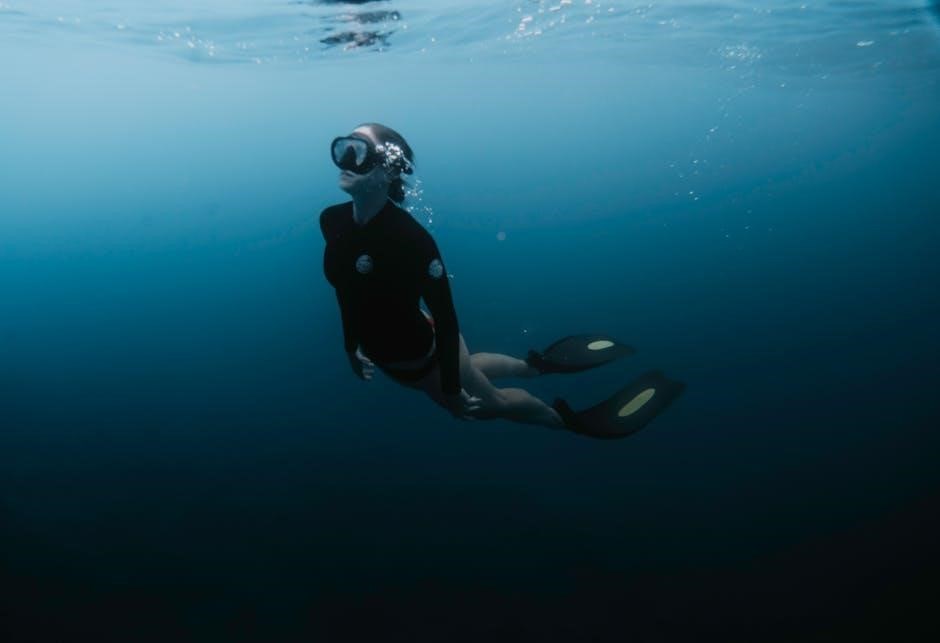
Final Tips for Selecting the Ideal Wetsuit
When selecting the perfect wetsuit, prioritize water temperature, diving activity, and personal comfort. Match thickness to your diving environment, ensuring flexibility for mobility. Consider a split-thickness suit for versatility. Try before buying to ensure a snug, comfortable fit. Don’t overlook features like hoods or boots for added warmth. Remember, the right balance between warmth and mobility enhances performance. Always test the suit in water-like conditions to gauge comfort. Lastly, seek advice from experienced divers or professionals to make an informed decision tailored to your needs. A well-chosen wetsuit ensures safety, comfort, and an enjoyable diving experience.
Staying Warm and Comfortable Underwater
Staying warm and comfortable underwater is crucial for an enjoyable scuba diving experience. The right wetsuit thickness ensures your body retains warmth by trapping a thin layer of water close to your skin. Thicker suits are ideal for colder waters, while thinner options provide flexibility in warmer conditions. Layering with hoods, gloves, and boots can enhance warmth without sacrificing mobility. Proper fit is essential to avoid cold spots and restricted movement. By balancing warmth and flexibility, you can stay comfortable and focused during your dive, making every underwater adventure safe and enjoyable. A well-chosen wetsuit is key to thermal comfort and diving success.

